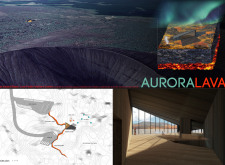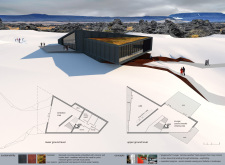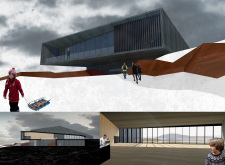5 key facts about this project
The design encompasses key features, including an exhibition area for geological and ecological education, a café that offers panoramic views of the dramatic terrain, and outdoor spaces for relaxation and observation. The building’s layout promotes visitor engagement with its surroundings while emphasizing the significance of preservation and environmental awareness.
Design Approach and Materiality
One of the unique aspects of this project is its use of local materials that echo the characteristics of the surrounding landscape. The incorporation of stamped concrete panels embedded with volcanic ash gives a rugged appearance, complementing the natural textures of the lava fields. Corten steel is utilized for its durability and aesthetic alignment with the environment, allowing the structure to age gracefully while minimizing maintenance. The project further employs an intensive green roof, integrating native plant species that enhance biodiversity.
The design emphasizes sustainability through the incorporation of geothermal heat pumps, ensuring energy efficiency while utilizing Iceland’s abundant geothermal resources. This holistic approach not only addresses environmental concerns but also reinforces the connection between the building and its ecological context.
Visitor Experience and Spatial Organization
The visitor experience is carefully curated through a thoughtful spatial organization that encourages exploration and interaction with both the architecture and the environment. Key spaces within the centre include the central exhibition area, which facilitates educational programming focused on the geological and environmental significance of the lava fields. The café and lounge areas are strategically oriented to provide visitors with engaging views, promoting a relaxed atmosphere.
Additionally, designated viewing areas for aurora observation are integral to the design, featuring large glass expanses that frame the surrounding landscape. These spaces allow for an immersive experience, encouraging visitors to engage with the natural beauty of Iceland’s skies.
For an in-depth understanding of the architectural concepts and planning details, exploring the architectural plans, architectural sections, and architectural designs of the project will provide greater insights into its innovative approach and functional attributes. This analysis illustrates how the Iceland Black Lava Fields Visitors Centre stands apart in its commitment to sustainability, visitor engagement, and contextual design, making it a noteworthy example of contemporary architecture in nature.


























